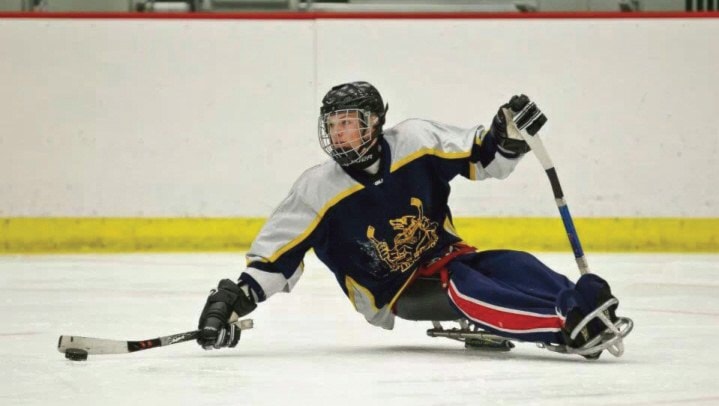Tanner Fandrey has been playing sports all his life.
Fandrey, a sledge hockey player with Olympic ambitions, said he has always been fond of sports, particularly skiing and hockey, and they have been a big part of his life since he was able to stand.
“I could ski as soon as I could walk,” said Fandrey. “I played hockey since Dynamite...throughout middle school I played all the school sports; volleyball, basketball football, track and field, all that stuff. So ever since I can remember I have been super athletic.”
Fandrey said he enjoys playing sports because it is a good way to let out energy and he always feels he has accomplished something afterwards. He added that he is also incredibly competitive.
While Fandrey is still very competitive, athletic and a high-level athlete, his involvement in sports has changed somewhat in the last few years.
In 2009 at the age of 13, Fandrey was playing Bantam A Hockey in Red Deer and came home from a game with a sore back.
He thought little of it, thinking it was regular soreness from having physically exerted himself during the game.
However, a week later, Fandrey’s leg seized up so badly it became difficult to move. He visited several doctors, all who prescribed different medications and said Fandrey was just experiencing severe growing pains.
Eventually, Fandrey’s leg became difficult to move at all.
It was at that point doctors did an ultrasound where they found a pocket of fluid in Fandrey’s right hip that was restricting his blood flow. He then underwent immediate surgery to have the fluid removed.
Later, doctors discovered that Fandrey’s hip was in stage three of a four-stage disease called Avascular Necrosis, which meant his hip was rapidly deteriorating due to a lack of blood flow.
If Fandrey continued to remain active in sports, he risked completely destroying his hip.
A year later to the day, Fandrey had an identical surgery done on his left hip to remove another pocket of fluid.
At this point, Fandrey’s doctors were very confused because Avascular Necrosis cannot move to different parts of the body, said Fandrey.
So, doctors began looking for the cause of the problem and three years after the problem began, a mistake during an MRI exam led doctors to take a picture of Fandrey’s spine instead of his hip.
However, that mistake allowed them to see the inflammation in Fandrey’s spine, Ankylosing Spondylitis.
Fandrey said his doctors now believe that the Ankylosing Spondylitis became so inflamed because of the vigorous sports that Fandrey had been doing that it had moved into both his hips at different times, causing Avascular Necrosis as well.
After being diagnosed, Fandrey was told he would never play hockey again and his disability would have a huge negative impact on his life.
Fandrey said he was depressed, but that he also was not willing to let his physical limitations keep him from playing sports.
Through his father, who works as a manager at a hockey rink in Red Deer, Fandrey became introduced to sledge hockey.
Soon, he discovered that he could still play hockey, albeit a different sort, despite what his doctors had said.
Sledge hockey is more similar to stand-up hockey than most people might think, said Fandrey.
He said most of the strategies and skills involved in both sports are the same, thus his knowledge of hockey was transferable.
“It’s full contact, just like stand-up hockey,” said Fandrey. He added that all the calls and infractions are the same as well, with a few exceptions.
“Obviously, we don’t have tripping.”
The biggest difference between the sports, other than the players being on sleds instead of skates, is the muscles used to move around the ice, said Fandrey.
He explained that, whereas stand-up hockey is very dependent on lower body strength for movement and speed, sledge hockey depends on upper body strength.
“It’s the exact same game of hockey,” said Fandrey. “The difference is, we move from using our biggest muscles to move around the ice, to using our smallest muscles to move around the ice.”
What disabilities players have also plays into how they play in sledge hockey.
As a stand-up hockey player, Fandrey was a goalie and had “Massive legs,” he said. As a sledge hockey player, he plays defense.
Fandrey said this is partly because while he doesn’t use his legs in sledge hockey, he still has them and thus has more weight to hit opposing players with than say, a player with a leg amputation.
Fandrey said amputees are typically faster as they have less weight to carry around and therefore are better suited playing forward.
Now, Fandrey plays with a high-level sledge hockey team, Edmonton Impact. He is also training with members of Team Canada and hopes to earn a spot on the 2018 Canadian Olympic Team.
In addition to sledge hockey, Fandrey also still participates in skiing by sit-skiing and also skis with the Alberta Alpine Team, though lately his training has been much more focused towards sledge hockey.
